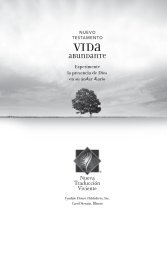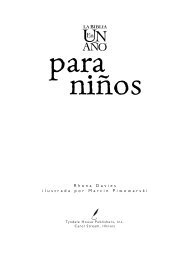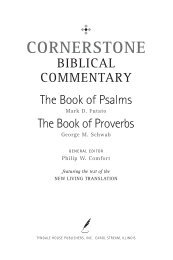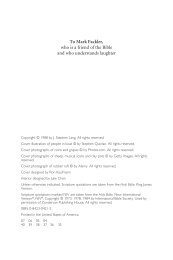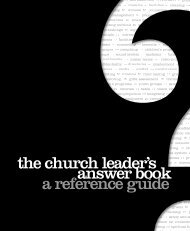Cornerstone Biblical Commentary: Luke and Acts - Tyndale House ...
Cornerstone Biblical Commentary: Luke and Acts - Tyndale House ...
Cornerstone Biblical Commentary: Luke and Acts - Tyndale House ...
You also want an ePaper? Increase the reach of your titles
YUMPU automatically turns print PDFs into web optimized ePapers that Google loves.
33 LUKE 1:5-7<br />
cerned to teach <strong>and</strong> instruct their readers, <strong>and</strong> both were committed to the use of responsible<br />
historical methods to arrive at the truth. Both also utilized “the most<br />
trustworthy authorities”; in <strong>Luke</strong>’s case, these included those who were “eyewitnesses”<br />
of the events of the life of Christ <strong>and</strong> of the early disciples. Finally, both<br />
were concerned to demonstrate their historical credibility by offering convincing<br />
evidence or “proof” (the word tekmerion [TG5039, ZG5447] being used by both Josephus<br />
[Against Apion 1.2] <strong>and</strong> <strong>Luke</strong> [<strong>Acts</strong> 1:3, lit. “with many proofs”]).<br />
There is, however, one significant difference in approach between <strong>Luke</strong> <strong>and</strong> Josephus.<br />
Josephus was rather critical of some of his historical predecessors who, in<br />
his opinion, had done less than justice to the Jewish people. <strong>Luke</strong>, on the other<br />
h<strong>and</strong>, did not attack or disparage those who had written before him. All the same,<br />
he believed that he had something distinctive to contribute <strong>and</strong> set out to produce<br />
“a careful account” of Christian origins, building constructively on those who had<br />
gone before him. He wanted to give Theophilus <strong>and</strong> all his readers or auditors<br />
(those who hear the text orally) solid grounds to reassure them of the truth they had<br />
been taught (1:4). <strong>Luke</strong> undertook his historical work with the utmost seriousness—the<br />
task of studying the sources, interrogating the witnesses, evaluating the<br />
evidence, <strong>and</strong> arranging the matter in a logical way. For him, responsible critical investigation<br />
of sources <strong>and</strong> evidence was absolutely necessary to the historiographical<br />
task he had set for himself. His aim was to provide a narrative or “account”<br />
(diegesis [TG1335, ZG1456], 1:1) that would offer solid information about Christ <strong>and</strong> the<br />
early church. <strong>Luke</strong>’s “order” (kathexes [TG2517, ZG2759], 1:3) is not precisely defined <strong>and</strong><br />
should be interpreted as synonymous with “systematic,” as Stein has argued<br />
(1983). For instance, the journey of Jesus to Jerusalem is an excellent example of<br />
<strong>Luke</strong>’s principle of order, though incidents in this section are not always presented<br />
in chronological sequence (9:51–19:27; so Stagg 1967:499-512). “The ‘main point’<br />
of the Prologue [<strong>and</strong> the “order” it claims] is that ‘Christianity is true <strong>and</strong> is capable<br />
of confirmation by appeal to what has happened’” (Morris 1974:67, quoting<br />
Stonehouse 1951:44).<br />
◆ II. The Nativity Stories (1:5–2:52)<br />
A. The Birth of John the Baptist Foretold (1:5-25)<br />
1. Zechariah’s background (1:5-7)<br />
5 When Herod was king of Judea, there<br />
was a Jewish priest named Zechariah.<br />
He was a member of the priestly order of<br />
Abijah, <strong>and</strong> his wife, Elizabeth, was also<br />
from the priestly line of Aaron. 6 Zechariah<br />
<strong>and</strong> Elizabeth were righteous in God’s<br />
eyes, careful to obey all of the Lord’s comm<strong>and</strong>ments<br />
<strong>and</strong> regulations. 7 They had<br />
no children because Elizabeth was unable<br />
to conceive, <strong>and</strong> they were both very old.<br />
NOTES<br />
1:5 Herod was king of Judea. This was Herod the Great, who ruled from 37 to 4 BC over<br />
Judea, Galilee, Samaria, <strong>and</strong> a large part of Perea <strong>and</strong> Syria. On the life of Herod the Great,<br />
see Grant 1971.





